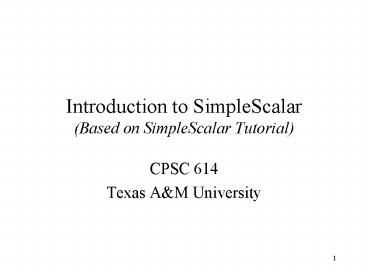Introduction to SimpleScalar (Based on SimpleScalar Tutorial) - PowerPoint PPT Presentation
Title:
Introduction to SimpleScalar (Based on SimpleScalar Tutorial)
Description:
fetch:ifqsize size -instruction fetch queue size (in insts) ... 179.art. data. ref. test. train. input. output. Directory organization. src. 164.gzip. SimPoint ... – PowerPoint PPT presentation
Number of Views:816
Avg rating:3.0/5.0
Title: Introduction to SimpleScalar (Based on SimpleScalar Tutorial)
1
Introduction to SimpleScalar(Based on
SimpleScalar Tutorial)
- CPSC 614
- Texas AM University
2
Overview
- What is an architectural simulator?
- a tool that reproduces the behavior of a
computing device - Why we use a simulator?
- Leverage a faster, more flexible software
development cycle - Permit more design space exploration
- Facilitates validation before H/W becomes
available - Level of abstraction is tailored by design task
- Possible to increase/improve system
instrumentation - Usually less expensive than building a real system
3
A Taxonomy of Simulation Tools
Shaded tools are included in SimpleScalar Tool Set
4
Functional vs. Performance
- Functional simulators implement the architecture.
- Perform real execution
- Implement what programmers see
- Performance simulators implement the
microarchitecture. - Model system resources/internals
- Concern about time
- Do not implement what programmers see
5
Trace- vs. Execution-Driven
- Trace-Driven
- Simulator reads a trace of the instructions
captured during a previous execution - Easy to implement, no functional components
necessary
- Execution-Driven
- Simulator runs the program (trace-on-the-fly)
- Hard to implement
- Advantages
- Faster than tracing
- No need to store traces
- Register and memory values usually are not in
trace - Support mis-speculation cost modeling
6
SimpleScalar Tool Set
- Computer architecture research test bed
- Compilers, assembler, linker, libraries, and
simulators - Targeted to the virtual SimpleScalar architecture
- Hosted on most any Unix-like machine
7
Advantages of SimpleScalar
- Highly flexible
- functional simulator performance simulator
- Portable
- Host virtual target runs on most Unix-like
systems - Target simulators can support multiple ISAs
- Extensible
- Source is included for compiler, libraries,
simulators - Easy to write simulators
- Performance
- Runs codes approaching real sizes
8
Simulator Suite
Sim-Fast
Sim-Safe
Sim-Profile
Sim-Cache Sim-BPred
Sim-Outorder
- 300 lines
- functional
- 4 MIPS
- 350 lines
- functional w/checks
- 900 lines
- functional
- Lot of stats
- lt 1000 lines
- functional
- Cache stats
- Branch stats
- 3900 lines
- performance
- OoO issue
- Branch pred.
- Mis-spec.
- ALUs
- Cache
- TLB
- 200 KIPS
Performance
Detail
9
Sim-Fast
- Functional simulation
- Optimized for speed
- Assumes no cache
- Assumes no instruction checking
- Does not support Dlite!
- Does not allow command line arguments
- lt300 lines of code
10
Sim-Cache
- Cache simulation
- Ideal for fast simulation of caches (if the
effect of cache performance on execution time is
not necessary) - Accepts command line arguments for
- level 1 2 instruction and data caches
- TLB configuration (data and instruction)
- Flush and compress
- and more
- Ideal for performing high-level cache studies
that dont take access time of the caches into
account
11
Sim-Bpred
- Simulate different branch prediction mechanisms
- Generate prediction hit and miss rate reports
- Does not simulate the effect of branch prediction
on total execution time - nottaken
- taken
- perfect
- bimod bimodal predictor
- 2lev 2-level adaptive predictor
- comb combined predictor (bimodal and 2-level)
12
Sim-Profile
- Program Profiler
- Generates detailed profiles, by symbol and by
address - Keeps track of and reports
- Dynamic instruction counts
- Instruction class counts
- Branch class counts
- Usage of address modes
- Profiles of the text data segment
13
Sim-Outorder
- Most complicated and detailed simulator
- Supports out-of-order issue and execution
- Provides reports
- branch prediction
- cache
- external memory
- various configuration
14
Sim-Outorder HW Architecture
Register Scheduler
Exe
Writeback
Commit
Fetch
Dispatch
Memory Scheduler
Mem
I-Cache
I-TLB
D-Cache
D-TLB
Virtual Memory
15
Sim-Outorder (Main Loop)
- sim_main() in sim-outorder.c
- ruu_init()
- for()
- ruu_commit()
- ruu_writeback()
- lsq_refresh()
- ruu_issue()
- ruu_dispatch()
- ruu_fetch()
- Executed once for each simulated machine cycle
- Walks pipeline from Commit to Fetch
- Reverse traversal handles inter-stage latch
synchronization by only one pass
16
RUU/LSQ in Sim-Outorder
- RUU (Register Update Unit)
- Handles register synchronization/communication
- Serves as reorder buffer and reservation stations
- Performs out-of-order issue when register and
memory dependences are satisfied - LSQ (Load/Store Queue)
- Handles memory synchronization/communication
- Contains all loads and stores in program order
- Relationship between RUU and LSQ
- Memory dependencies are resolved by LSQ
- Load/Store effective address calculated in RUU
17
Specifying Sim-outorder
-fetchifqsize ltsizegt -instruction fetch queue
size (in insts) -fetchmplat ltcyclesgt - extra
branch miss-prediction latency (cycles)
- -bpred lttypegt
- -bpredbimod ltsizegt
- -bpred2lev ltl1sizegt ltl2sizegt lthist_sizegt
- -config ltfilegt
- -dumpconfig ltfilegt
For Assignment 1, change at least l1size.
sim-outorder config ltfilegt ltbenchmark command
linegt
18
Benchmark
- SPEC CPU 2000
- Integer/Floating Point
- http//www.spec.org
- For homework Alpha binaries, input data files
input
ref
179.art
data
output
test
src
CFP2000
164.gzip
train
CINT2000
Directory organization
19
SimPoint
- Goal
- To find simulation points that accurately
representatives the complete execution program
based on phase analysis - Single Simulation Points (Standard for homework)
- If the Simulation Point is 90, then you start
simulating at instruction 90 100 million (9
billion) and stop simulating at instruction 9.1
billion. - Multiple Simulation Points
20
References
- SimpleScalar Tutorial/Hack Guide
- Read tutorial/Run, test, and debug
- WWW Computer Architecture
- http//www.cs.wisc.edu/arch/www































